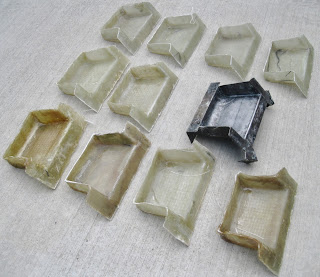This is the flip side of the instrument module. Clearly, a whole lotta screws have to come out to get to just the speedometer.
Here the speedometer is out of the module. If the speedometer was all that needed attention, that's as far as I'd have to go. But life ain't that simple. This critter was dirty and dusty INSIDE the plastic face plate, so it all had to come apart. In addition to the photos, I made a couple of pages of illustrated notes so I had some chance of getting it all back together on the first pass.....
Here is the bugger all apart. A lot of cleaning was necessary on ALL the internal parts of the module, and then I reconditioned the speedometer itself [lower left in the photo above].
So, after a lot of cleaning, wiping, dusting and polishing--along with liberal amounts of questioning the ancestry of the designer of this conglomeration of parts--it's done, pretty and ready to go get dusty and grimy once again in a drop top Merc. And...the odo now odo's---HA!






















































